HSC203 Indigenous Health Perspectives: Alcohol & Health Outcomes
VerifiedAdded on 2023/04/25
|7
|1612
|149
Essay
AI Summary
This essay examines the pervasive issue of alcohol consumption and its detrimental effects on the health of Indigenous Australians. It highlights the disproportionately high rates of alcohol abuse within this population compared to non-Indigenous Australians and explores the historical and social factors contributing to this disparity. The essay delves into the health consequences of excessive alcohol intake, including liver cirrhosis, obesity, diabetes, and fetal alcohol spectrum disorders, emphasizing the strain on healthcare resources and the disruption of family and community life. Furthermore, it discusses potential strategies for addressing alcoholism at the individual, community, and governmental levels, such as responsible drinking campaigns, community-based interventions, and government-sponsored rehabilitation programs. The essay concludes by advocating for a multi-faceted approach involving all stakeholders to mitigate the adverse effects of alcohol abuse and improve the health and well-being of Indigenous communities in Australia. Desklib provides access to similar essays and resources for students.
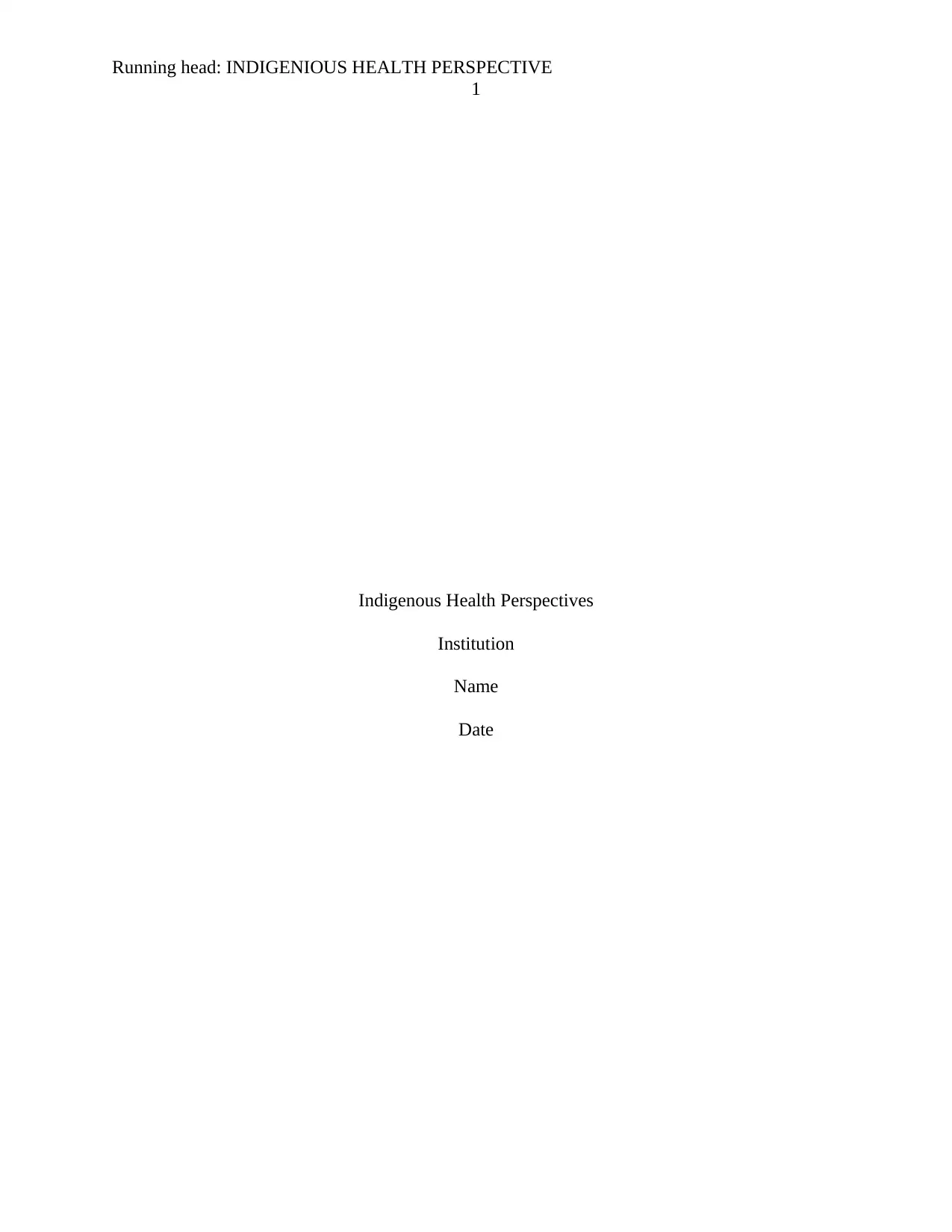
Running head: INDIGENIOUS HEALTH PERSPECTIVE
1
Indigenous Health Perspectives
Institution
Name
Date
1
Indigenous Health Perspectives
Institution
Name
Date
Paraphrase This Document
Need a fresh take? Get an instant paraphrase of this document with our AI Paraphraser
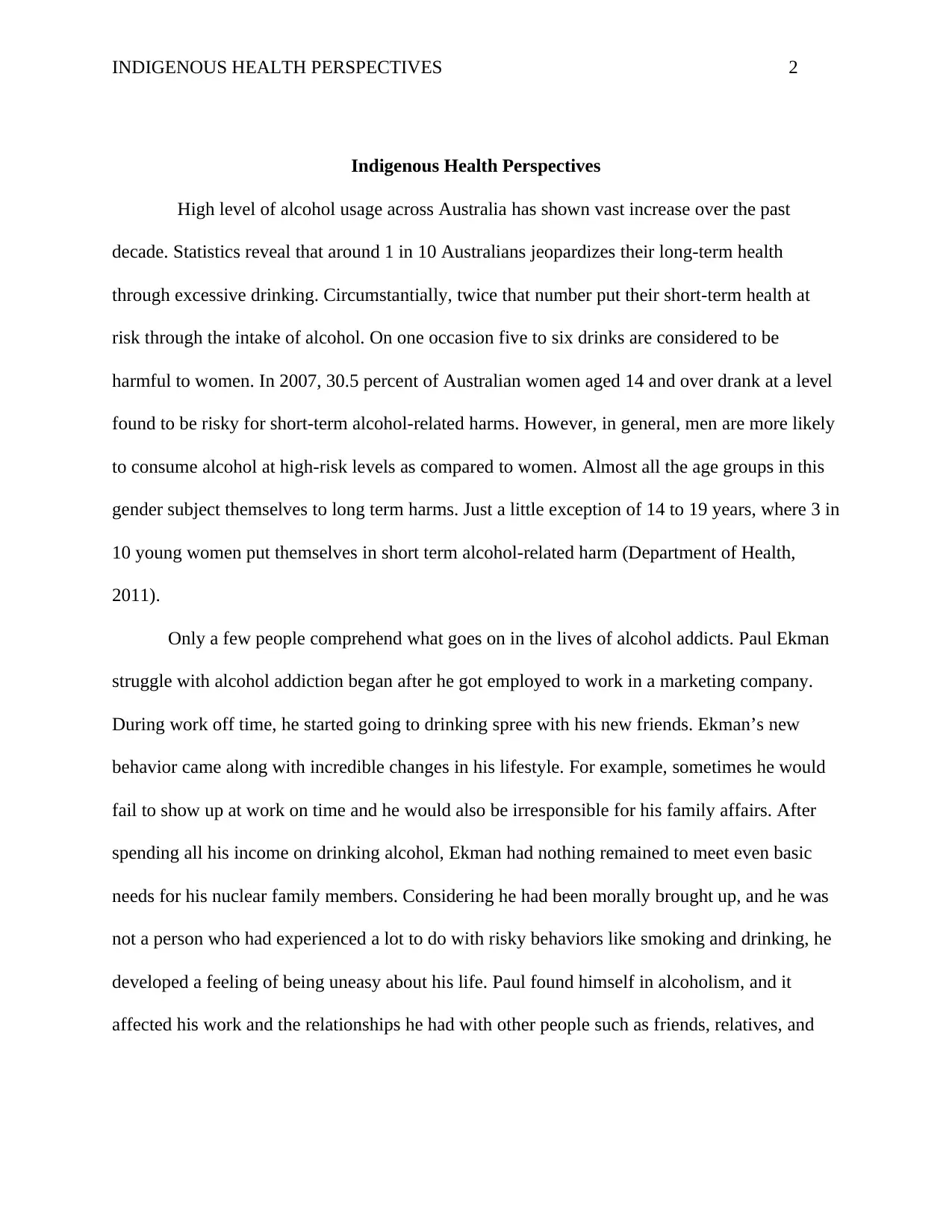
INDIGENOUS HEALTH PERSPECTIVES 2
Indigenous Health Perspectives
High level of alcohol usage across Australia has shown vast increase over the past
decade. Statistics reveal that around 1 in 10 Australians jeopardizes their long-term health
through excessive drinking. Circumstantially, twice that number put their short-term health at
risk through the intake of alcohol. On one occasion five to six drinks are considered to be
harmful to women. In 2007, 30.5 percent of Australian women aged 14 and over drank at a level
found to be risky for short-term alcohol-related harms. However, in general, men are more likely
to consume alcohol at high-risk levels as compared to women. Almost all the age groups in this
gender subject themselves to long term harms. Just a little exception of 14 to 19 years, where 3 in
10 young women put themselves in short term alcohol-related harm (Department of Health,
2011).
Only a few people comprehend what goes on in the lives of alcohol addicts. Paul Ekman
struggle with alcohol addiction began after he got employed to work in a marketing company.
During work off time, he started going to drinking spree with his new friends. Ekman’s new
behavior came along with incredible changes in his lifestyle. For example, sometimes he would
fail to show up at work on time and he would also be irresponsible for his family affairs. After
spending all his income on drinking alcohol, Ekman had nothing remained to meet even basic
needs for his nuclear family members. Considering he had been morally brought up, and he was
not a person who had experienced a lot to do with risky behaviors like smoking and drinking, he
developed a feeling of being uneasy about his life. Paul found himself in alcoholism, and it
affected his work and the relationships he had with other people such as friends, relatives, and
Indigenous Health Perspectives
High level of alcohol usage across Australia has shown vast increase over the past
decade. Statistics reveal that around 1 in 10 Australians jeopardizes their long-term health
through excessive drinking. Circumstantially, twice that number put their short-term health at
risk through the intake of alcohol. On one occasion five to six drinks are considered to be
harmful to women. In 2007, 30.5 percent of Australian women aged 14 and over drank at a level
found to be risky for short-term alcohol-related harms. However, in general, men are more likely
to consume alcohol at high-risk levels as compared to women. Almost all the age groups in this
gender subject themselves to long term harms. Just a little exception of 14 to 19 years, where 3 in
10 young women put themselves in short term alcohol-related harm (Department of Health,
2011).
Only a few people comprehend what goes on in the lives of alcohol addicts. Paul Ekman
struggle with alcohol addiction began after he got employed to work in a marketing company.
During work off time, he started going to drinking spree with his new friends. Ekman’s new
behavior came along with incredible changes in his lifestyle. For example, sometimes he would
fail to show up at work on time and he would also be irresponsible for his family affairs. After
spending all his income on drinking alcohol, Ekman had nothing remained to meet even basic
needs for his nuclear family members. Considering he had been morally brought up, and he was
not a person who had experienced a lot to do with risky behaviors like smoking and drinking, he
developed a feeling of being uneasy about his life. Paul found himself in alcoholism, and it
affected his work and the relationships he had with other people such as friends, relatives, and
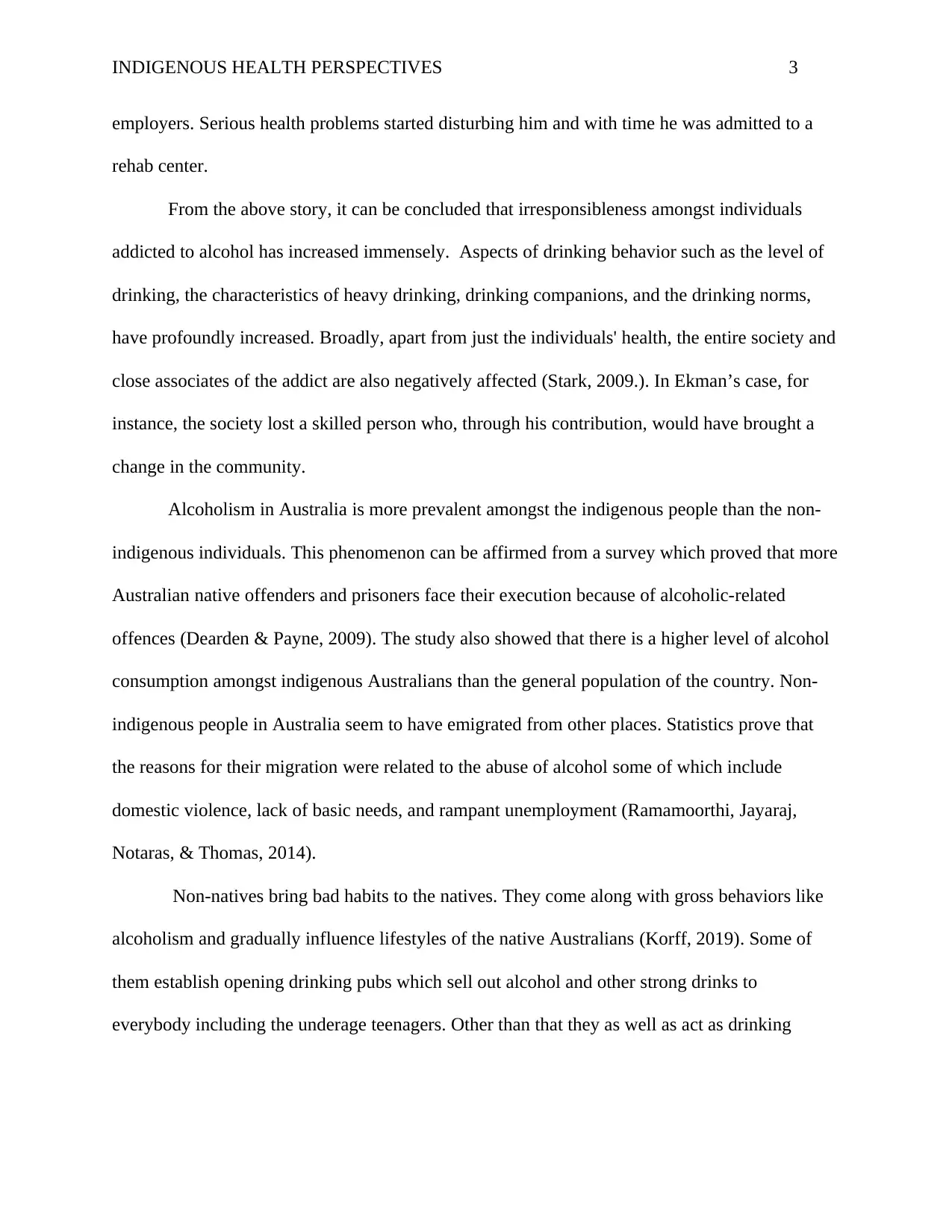
INDIGENOUS HEALTH PERSPECTIVES 3
employers. Serious health problems started disturbing him and with time he was admitted to a
rehab center.
From the above story, it can be concluded that irresponsibleness amongst individuals
addicted to alcohol has increased immensely. Aspects of drinking behavior such as the level of
drinking, the characteristics of heavy drinking, drinking companions, and the drinking norms,
have profoundly increased. Broadly, apart from just the individuals' health, the entire society and
close associates of the addict are also negatively affected (Stark, 2009.). In Ekman’s case, for
instance, the society lost a skilled person who, through his contribution, would have brought a
change in the community.
Alcoholism in Australia is more prevalent amongst the indigenous people than the non-
indigenous individuals. This phenomenon can be affirmed from a survey which proved that more
Australian native offenders and prisoners face their execution because of alcoholic-related
offences (Dearden & Payne, 2009). The study also showed that there is a higher level of alcohol
consumption amongst indigenous Australians than the general population of the country. Non-
indigenous people in Australia seem to have emigrated from other places. Statistics prove that
the reasons for their migration were related to the abuse of alcohol some of which include
domestic violence, lack of basic needs, and rampant unemployment (Ramamoorthi, Jayaraj,
Notaras, & Thomas, 2014).
Non-natives bring bad habits to the natives. They come along with gross behaviors like
alcoholism and gradually influence lifestyles of the native Australians (Korff, 2019). Some of
them establish opening drinking pubs which sell out alcohol and other strong drinks to
everybody including the underage teenagers. Other than that they as well as act as drinking
employers. Serious health problems started disturbing him and with time he was admitted to a
rehab center.
From the above story, it can be concluded that irresponsibleness amongst individuals
addicted to alcohol has increased immensely. Aspects of drinking behavior such as the level of
drinking, the characteristics of heavy drinking, drinking companions, and the drinking norms,
have profoundly increased. Broadly, apart from just the individuals' health, the entire society and
close associates of the addict are also negatively affected (Stark, 2009.). In Ekman’s case, for
instance, the society lost a skilled person who, through his contribution, would have brought a
change in the community.
Alcoholism in Australia is more prevalent amongst the indigenous people than the non-
indigenous individuals. This phenomenon can be affirmed from a survey which proved that more
Australian native offenders and prisoners face their execution because of alcoholic-related
offences (Dearden & Payne, 2009). The study also showed that there is a higher level of alcohol
consumption amongst indigenous Australians than the general population of the country. Non-
indigenous people in Australia seem to have emigrated from other places. Statistics prove that
the reasons for their migration were related to the abuse of alcohol some of which include
domestic violence, lack of basic needs, and rampant unemployment (Ramamoorthi, Jayaraj,
Notaras, & Thomas, 2014).
Non-natives bring bad habits to the natives. They come along with gross behaviors like
alcoholism and gradually influence lifestyles of the native Australians (Korff, 2019). Some of
them establish opening drinking pubs which sell out alcohol and other strong drinks to
everybody including the underage teenagers. Other than that they as well as act as drinking
⊘ This is a preview!⊘
Do you want full access?
Subscribe today to unlock all pages.

Trusted by 1+ million students worldwide
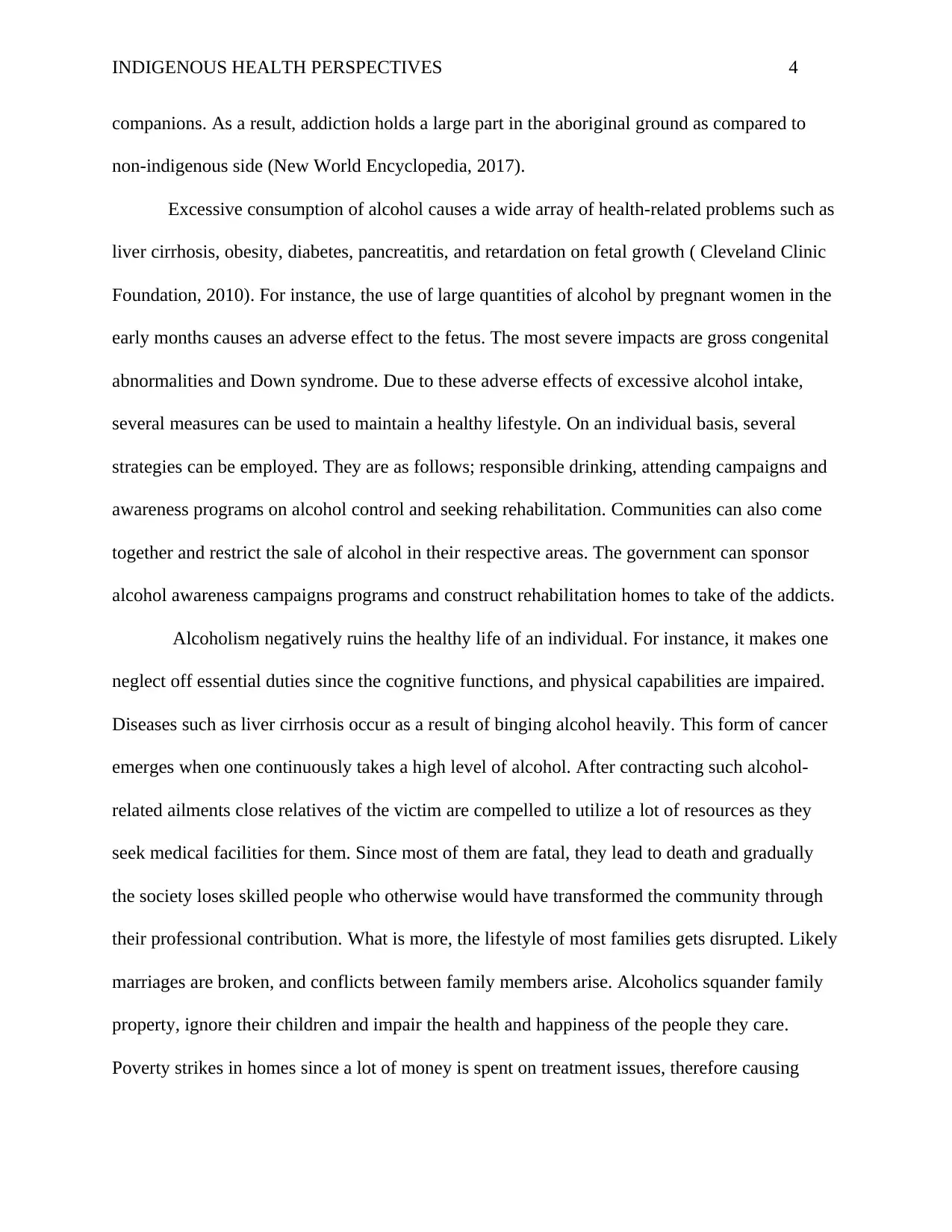
INDIGENOUS HEALTH PERSPECTIVES 4
companions. As a result, addiction holds a large part in the aboriginal ground as compared to
non-indigenous side (New World Encyclopedia, 2017).
Excessive consumption of alcohol causes a wide array of health-related problems such as
liver cirrhosis, obesity, diabetes, pancreatitis, and retardation on fetal growth ( Cleveland Clinic
Foundation, 2010). For instance, the use of large quantities of alcohol by pregnant women in the
early months causes an adverse effect to the fetus. The most severe impacts are gross congenital
abnormalities and Down syndrome. Due to these adverse effects of excessive alcohol intake,
several measures can be used to maintain a healthy lifestyle. On an individual basis, several
strategies can be employed. They are as follows; responsible drinking, attending campaigns and
awareness programs on alcohol control and seeking rehabilitation. Communities can also come
together and restrict the sale of alcohol in their respective areas. The government can sponsor
alcohol awareness campaigns programs and construct rehabilitation homes to take of the addicts.
Alcoholism negatively ruins the healthy life of an individual. For instance, it makes one
neglect off essential duties since the cognitive functions, and physical capabilities are impaired.
Diseases such as liver cirrhosis occur as a result of binging alcohol heavily. This form of cancer
emerges when one continuously takes a high level of alcohol. After contracting such alcohol-
related ailments close relatives of the victim are compelled to utilize a lot of resources as they
seek medical facilities for them. Since most of them are fatal, they lead to death and gradually
the society loses skilled people who otherwise would have transformed the community through
their professional contribution. What is more, the lifestyle of most families gets disrupted. Likely
marriages are broken, and conflicts between family members arise. Alcoholics squander family
property, ignore their children and impair the health and happiness of the people they care.
Poverty strikes in homes since a lot of money is spent on treatment issues, therefore causing
companions. As a result, addiction holds a large part in the aboriginal ground as compared to
non-indigenous side (New World Encyclopedia, 2017).
Excessive consumption of alcohol causes a wide array of health-related problems such as
liver cirrhosis, obesity, diabetes, pancreatitis, and retardation on fetal growth ( Cleveland Clinic
Foundation, 2010). For instance, the use of large quantities of alcohol by pregnant women in the
early months causes an adverse effect to the fetus. The most severe impacts are gross congenital
abnormalities and Down syndrome. Due to these adverse effects of excessive alcohol intake,
several measures can be used to maintain a healthy lifestyle. On an individual basis, several
strategies can be employed. They are as follows; responsible drinking, attending campaigns and
awareness programs on alcohol control and seeking rehabilitation. Communities can also come
together and restrict the sale of alcohol in their respective areas. The government can sponsor
alcohol awareness campaigns programs and construct rehabilitation homes to take of the addicts.
Alcoholism negatively ruins the healthy life of an individual. For instance, it makes one
neglect off essential duties since the cognitive functions, and physical capabilities are impaired.
Diseases such as liver cirrhosis occur as a result of binging alcohol heavily. This form of cancer
emerges when one continuously takes a high level of alcohol. After contracting such alcohol-
related ailments close relatives of the victim are compelled to utilize a lot of resources as they
seek medical facilities for them. Since most of them are fatal, they lead to death and gradually
the society loses skilled people who otherwise would have transformed the community through
their professional contribution. What is more, the lifestyle of most families gets disrupted. Likely
marriages are broken, and conflicts between family members arise. Alcoholics squander family
property, ignore their children and impair the health and happiness of the people they care.
Poverty strikes in homes since a lot of money is spent on treatment issues, therefore causing
Paraphrase This Document
Need a fresh take? Get an instant paraphrase of this document with our AI Paraphraser
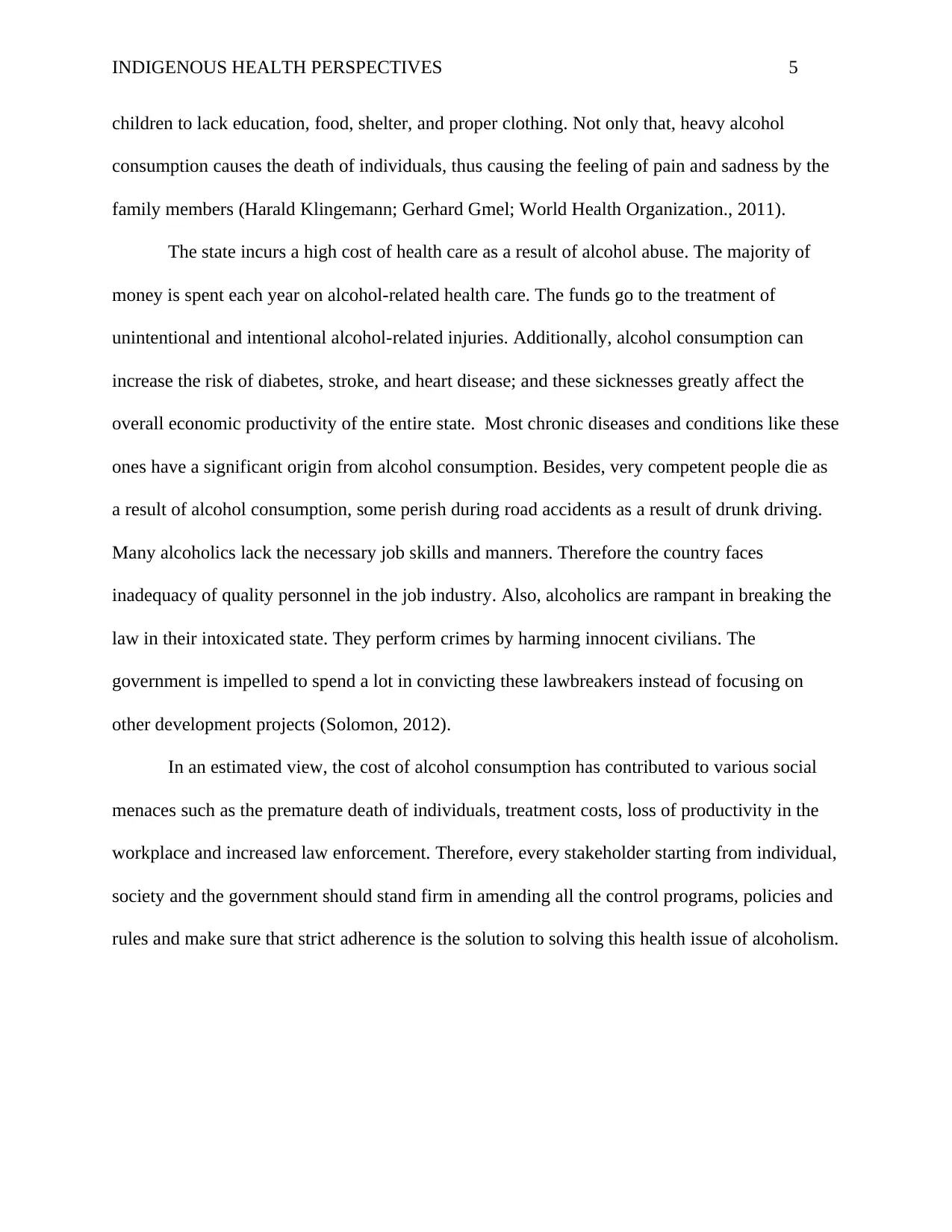
INDIGENOUS HEALTH PERSPECTIVES 5
children to lack education, food, shelter, and proper clothing. Not only that, heavy alcohol
consumption causes the death of individuals, thus causing the feeling of pain and sadness by the
family members (Harald Klingemann; Gerhard Gmel; World Health Organization., 2011).
The state incurs a high cost of health care as a result of alcohol abuse. The majority of
money is spent each year on alcohol-related health care. The funds go to the treatment of
unintentional and intentional alcohol-related injuries. Additionally, alcohol consumption can
increase the risk of diabetes, stroke, and heart disease; and these sicknesses greatly affect the
overall economic productivity of the entire state. Most chronic diseases and conditions like these
ones have a significant origin from alcohol consumption. Besides, very competent people die as
a result of alcohol consumption, some perish during road accidents as a result of drunk driving.
Many alcoholics lack the necessary job skills and manners. Therefore the country faces
inadequacy of quality personnel in the job industry. Also, alcoholics are rampant in breaking the
law in their intoxicated state. They perform crimes by harming innocent civilians. The
government is impelled to spend a lot in convicting these lawbreakers instead of focusing on
other development projects (Solomon, 2012).
In an estimated view, the cost of alcohol consumption has contributed to various social
menaces such as the premature death of individuals, treatment costs, loss of productivity in the
workplace and increased law enforcement. Therefore, every stakeholder starting from individual,
society and the government should stand firm in amending all the control programs, policies and
rules and make sure that strict adherence is the solution to solving this health issue of alcoholism.
children to lack education, food, shelter, and proper clothing. Not only that, heavy alcohol
consumption causes the death of individuals, thus causing the feeling of pain and sadness by the
family members (Harald Klingemann; Gerhard Gmel; World Health Organization., 2011).
The state incurs a high cost of health care as a result of alcohol abuse. The majority of
money is spent each year on alcohol-related health care. The funds go to the treatment of
unintentional and intentional alcohol-related injuries. Additionally, alcohol consumption can
increase the risk of diabetes, stroke, and heart disease; and these sicknesses greatly affect the
overall economic productivity of the entire state. Most chronic diseases and conditions like these
ones have a significant origin from alcohol consumption. Besides, very competent people die as
a result of alcohol consumption, some perish during road accidents as a result of drunk driving.
Many alcoholics lack the necessary job skills and manners. Therefore the country faces
inadequacy of quality personnel in the job industry. Also, alcoholics are rampant in breaking the
law in their intoxicated state. They perform crimes by harming innocent civilians. The
government is impelled to spend a lot in convicting these lawbreakers instead of focusing on
other development projects (Solomon, 2012).
In an estimated view, the cost of alcohol consumption has contributed to various social
menaces such as the premature death of individuals, treatment costs, loss of productivity in the
workplace and increased law enforcement. Therefore, every stakeholder starting from individual,
society and the government should stand firm in amending all the control programs, policies and
rules and make sure that strict adherence is the solution to solving this health issue of alcoholism.
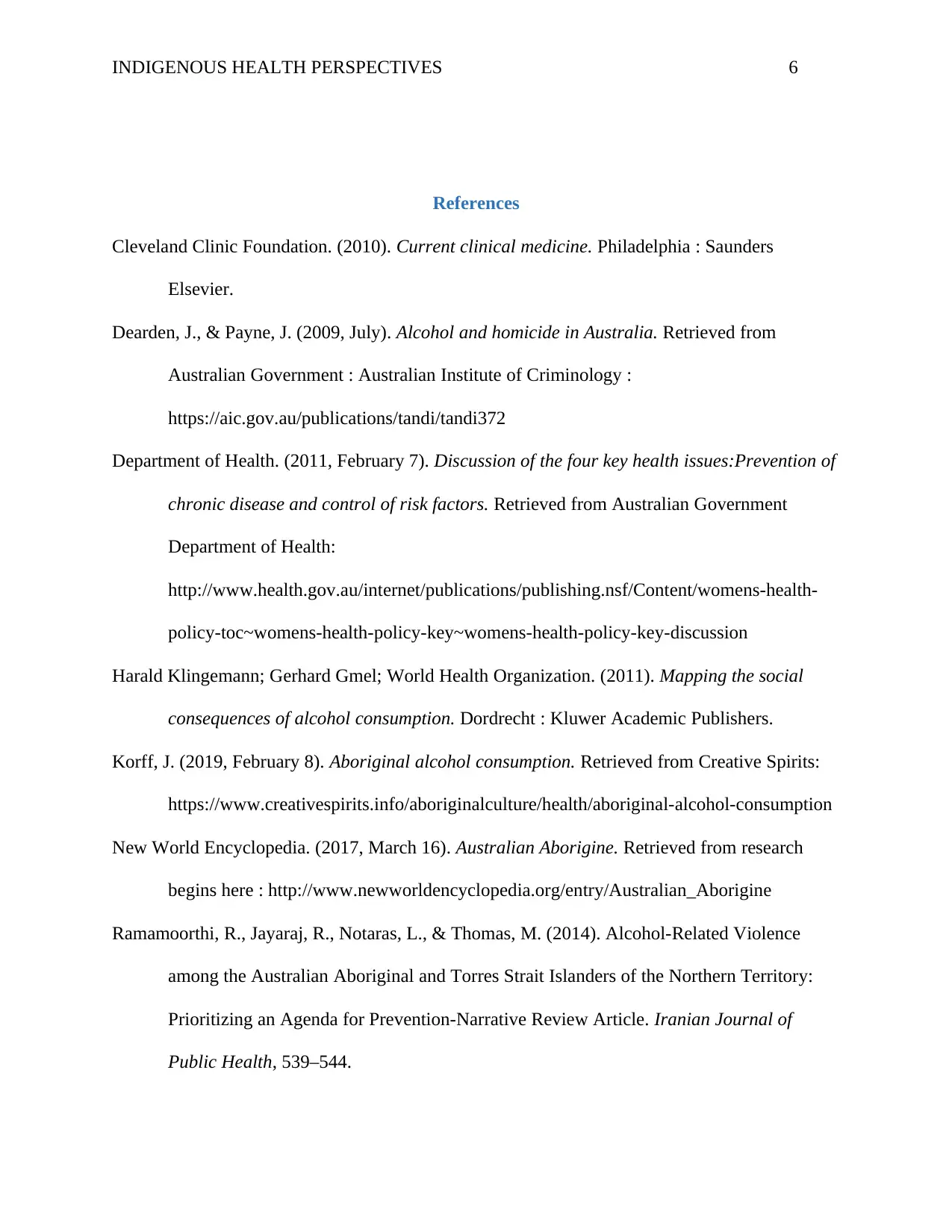
INDIGENOUS HEALTH PERSPECTIVES 6
References
Cleveland Clinic Foundation. (2010). Current clinical medicine. Philadelphia : Saunders
Elsevier.
Dearden, J., & Payne, J. (2009, July). Alcohol and homicide in Australia. Retrieved from
Australian Government : Australian Institute of Criminology :
https://aic.gov.au/publications/tandi/tandi372
Department of Health. (2011, February 7). Discussion of the four key health issues:Prevention of
chronic disease and control of risk factors. Retrieved from Australian Government
Department of Health:
http://www.health.gov.au/internet/publications/publishing.nsf/Content/womens-health-
policy-toc~womens-health-policy-key~womens-health-policy-key-discussion
Harald Klingemann; Gerhard Gmel; World Health Organization. (2011). Mapping the social
consequences of alcohol consumption. Dordrecht : Kluwer Academic Publishers.
Korff, J. (2019, February 8). Aboriginal alcohol consumption. Retrieved from Creative Spirits:
https://www.creativespirits.info/aboriginalculture/health/aboriginal-alcohol-consumption
New World Encyclopedia. (2017, March 16). Australian Aborigine. Retrieved from research
begins here : http://www.newworldencyclopedia.org/entry/Australian_Aborigine
Ramamoorthi, R., Jayaraj, R., Notaras, L., & Thomas, M. (2014). Alcohol-Related Violence
among the Australian Aboriginal and Torres Strait Islanders of the Northern Territory:
Prioritizing an Agenda for Prevention-Narrative Review Article. Iranian Journal of
Public Health, 539–544.
References
Cleveland Clinic Foundation. (2010). Current clinical medicine. Philadelphia : Saunders
Elsevier.
Dearden, J., & Payne, J. (2009, July). Alcohol and homicide in Australia. Retrieved from
Australian Government : Australian Institute of Criminology :
https://aic.gov.au/publications/tandi/tandi372
Department of Health. (2011, February 7). Discussion of the four key health issues:Prevention of
chronic disease and control of risk factors. Retrieved from Australian Government
Department of Health:
http://www.health.gov.au/internet/publications/publishing.nsf/Content/womens-health-
policy-toc~womens-health-policy-key~womens-health-policy-key-discussion
Harald Klingemann; Gerhard Gmel; World Health Organization. (2011). Mapping the social
consequences of alcohol consumption. Dordrecht : Kluwer Academic Publishers.
Korff, J. (2019, February 8). Aboriginal alcohol consumption. Retrieved from Creative Spirits:
https://www.creativespirits.info/aboriginalculture/health/aboriginal-alcohol-consumption
New World Encyclopedia. (2017, March 16). Australian Aborigine. Retrieved from research
begins here : http://www.newworldencyclopedia.org/entry/Australian_Aborigine
Ramamoorthi, R., Jayaraj, R., Notaras, L., & Thomas, M. (2014). Alcohol-Related Violence
among the Australian Aboriginal and Torres Strait Islanders of the Northern Territory:
Prioritizing an Agenda for Prevention-Narrative Review Article. Iranian Journal of
Public Health, 539–544.
⊘ This is a preview!⊘
Do you want full access?
Subscribe today to unlock all pages.

Trusted by 1+ million students worldwide

INDIGENOUS HEALTH PERSPECTIVES 7
Solomon, J. (2012). Alcoholism and clinical psychiatry. New York, New York London:
[England] Plenum Medical Book Company.
Solomon, J. (2012). Alcoholism and clinical psychiatry. New York, New York London:
[England] Plenum Medical Book Company.
1 out of 7
Your All-in-One AI-Powered Toolkit for Academic Success.
+13062052269
info@desklib.com
Available 24*7 on WhatsApp / Email
![[object Object]](/_next/static/media/star-bottom.7253800d.svg)
Unlock your academic potential
Copyright © 2020–2025 A2Z Services. All Rights Reserved. Developed and managed by ZUCOL.


